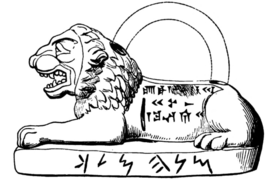Assyrian lion weights
|
Three of the lion weights in the British Museum. The table below lists all the known lion and duck weights from Nimrud as of the late 19th century. | |
 | |
| Material | Bronze |
|---|---|
| Writing | Phoenician language and cuneiform |
| Created | c. 800–700 BC |
| Discovered | 1845–51 |
| Present location | British Museum |
| Identification | ME 91220 |
The Assyrian lion weights are a group of bronze Mesopotamian weights from the 8th century BCE, with bilingual inscriptions in both cuneiform and Phoenician characters. The lion weights were discovered at Nimrud in the late 1840s and are now in the British Museum.[1]
The weights date from the 8th century BCE and they have bilingual inscriptions in both cuneiform and Phoenician characters. The Phoenician inscriptions are epigraphically from the same period as the Mesha Stele.[2][3] They are one of the most important groups of artifacts evidencing the "Aramaic" form of the Phoenician script.[4] At the time of their discovery, they were the oldest Phoenician-style inscription that had been discovered.[5]
Description
The set form a regular series diminishing in size from 30 cm to 2 cm in length. The larger weights have handles cast on to the bodies, and the smaller have rings attached to them. The group of weights also included stone weights in the shape of ducks. The weights represent the earliest known uncontested example of the Aramaic numeral system.[6] Eight of the lions are represented with the only known inscriptions from the short reign of Shalmaneser V.[7] Other similar lion weights were excavated at the Iranian site of Susa in 1901 by the French archaeologist Jacques de Morgan and are now in the Louvre in Paris.[8]
There are two known systems of weights and measures from the ancient Middle East. One system was based on a weight called the mina which could be broken down into sixty smaller weights called shekels. These lion weights, however, come from a different system which was based on the heavy mina which weighed about a kilogram. This system was still being used in the Persian period and is thought to have been used for weighing metals.
Discovery
The weights were discovered by Austen Henry Layard in his earliest excavations at Nimrud (1845–51). A pair of lamassu were found at a gateway, one of which had fallen against the other and had broken into several pieces. After lifting the statue, Layard's team discovered under it sixteen lion weights.[9] The artefacts were first deciphered by Edwin Norris, who confirmed that they had originally been used as weights.[10]
Gallery
-

1864 sketch of a Lion weight
-

1856 sketch of the inscriptions from Lions 1-8
-

1856 sketch of the inscriptions from Lions 9-15 and Ducks 1-5
-

Bronze lion weight from the acropolis in Susa, 6th-4th Centuries BC, Louvre
Bibliography
- Edwin Norris (1856), On the Assyrian and Babylonian Weights, Journal of the Royal Asiatic Society of Great Britain and Ireland, Volume 16 (editio princeps)
- Frederic Madden (1864), History of Jewish coinage, and of money in the Old and New Testament, B. Quaritch
- Fales, Frederick Mario (1995), Assyro-Aramaica : the Assyrian lion-weights, in Immigration and Emigration within the Ancient Near East, pages 33–55; editor: Festschrift E. Lipinski, Peeters
- British Museum description
References
- ↑ British Museum Collection
- ↑ The Alphabet: An Account of the Origin and Development of Letters, Kegan Paul, Trench, 1883, Isaac Taylor, page 133, "The lion weights from Nineveh, which bear the names of Assyrian kings who reigned during the second half of the 8th century, an engraved scarab found beneath the foundation of the palace of Sargon at Khorsabad, and the bronze vessel dedicated to the temple of Baal-Lebanon, which bears the name of Hiram, king of the Sidonians, are epigraphically of the same age, or nearly so, as the inscription of Mesha"
- ↑ Norris, 1856, p.215
- ↑ Epigraphic West Semitic Scripts, 2006, Elsevier, Christopher Rollston, p.503, quote: "Some of the most important evidence for the Aramaic cursive script series are the Hamat bricks, the Lion-Weights from Nineveh, and the Nimrud ostracon (all dating to the 8th century)."
- ↑ Henry Rawlinson (1865), Bilingual Readings: Cuneiform and Phœnician. Notes on Some Tablets in the British Museum, Containing Bilingual Legends (Assyrian and Phœnician), p.243, "Before concluding my notes on these tablet and seal legends, I would observe that they are among the most ancient specimens that we possess of Phoenician writing. I should select as the earliest specimens of all, the legends on the larger Lion Weights in the British Museum, one of which is clearly dated from the reign of Tiglath Pileser II. (b.c. 744-726). The other weights bear the royal names of Shalmaneser, Sargon, and Sennacherib."
- ↑ Numerical Notation: A Comparative History, CUP, 2010, Stephen Chrisomalis, page 71, ISBN 9781139485333
- ↑ The Oxford Guide to People & Places of the Bible, p.285, Bruce Manning Metzger, Michael D. Coogan, Oxford University Press, 2004, ISBN 9780195176100
- ↑ Louvre Collection
- ↑ Layard, Nineveh and its Remains, Murray, 1849, p.46-47: "I lifted the body with difficulty; and discovered under it sixteen copper lions, of admirable execution, forming a regular series, diminishing in size from the largest, which was above one foot in length, to the smallest, which scarcely exceeded an inch. A ring attached to the back of each, gave them the appearance of weights. In the same place were the fragments of an earthen vase, on which were represented two figures, with the wings and claws of a bird, the breasts of a woman, and the tail of a scorpion."
- ↑ Madden, 1864, p.249
